Episode #18: How Brands Can Leverage Content for Community Building
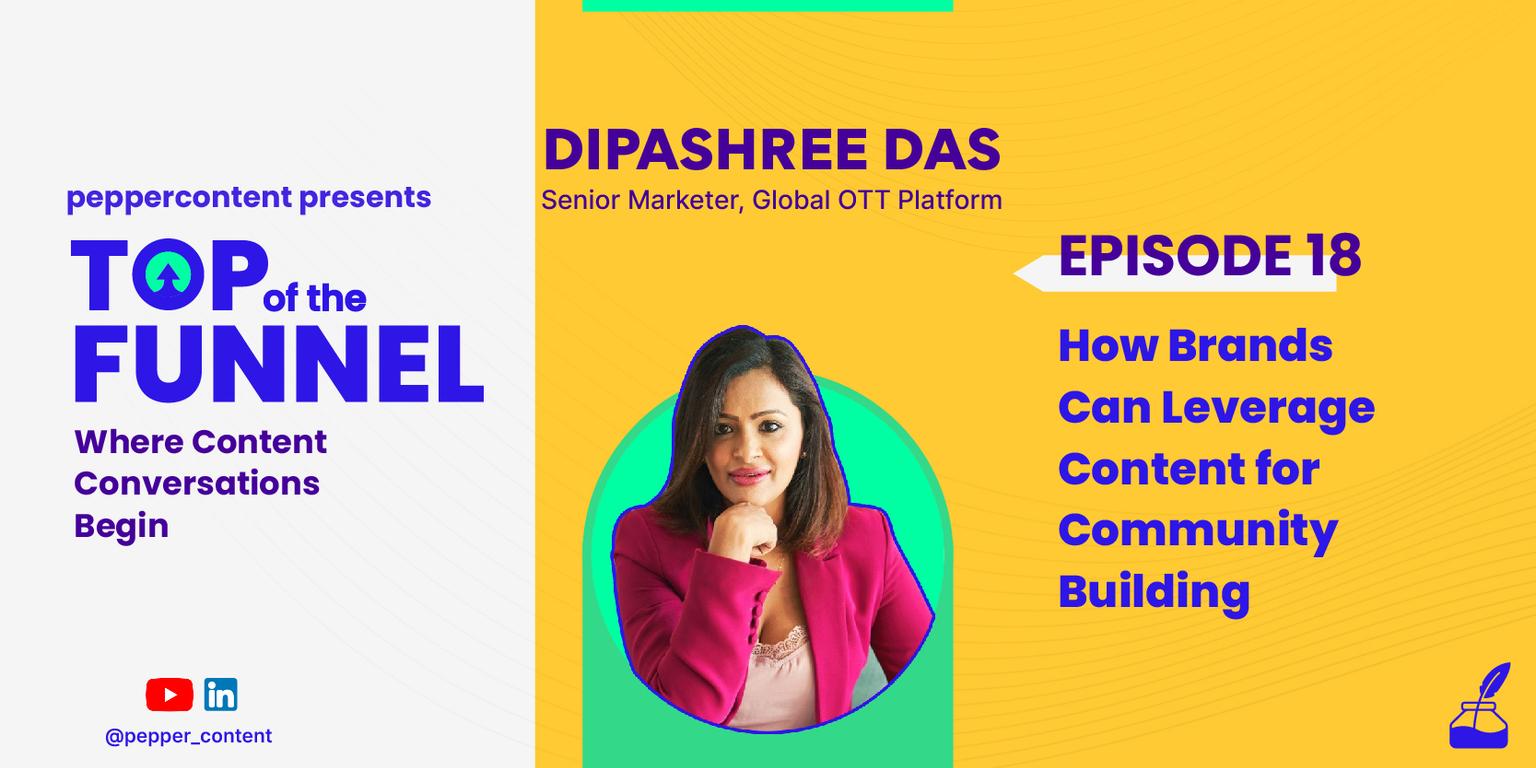
Why would a consumer give you their time? A brand’s content would appeal to its target audience only when it is informative, or entertaining, or different from what they have already consumed. In the wake of the pandemic, a void has risen. As physical touch remains impossible, online spaces have flourished to fill that void. Natasha Puri, Content Marketing Lead at Pepper Content, talks to Dipashree Das, who is a part of the Marketing team at Netflix India about the power of story-telling and content creation in crafting sustainable brands. She talks about how brands can leverage content to create a community, that would, in turn, become a powerful lead generation tool. Having had a long career in marketing and branding, Dipashree Das manages to tap into the exact pulse of her brand’s consumers.
Dipashree and her team have banked on a carefully executed, creative storytelling strategy to market their OTT content. The success of Money Heist and Sacred Games in not only India, but the world is a testament to their brilliantly executed plan. She also traces the evolution of content marketing, as it came to be in recent years, noting that a consumer-centric approach is at the heart of content marketing.
Natasha Puri: Hello everyone. Welcome to the Top of the Funnel, the series where conversations about content begin. Our guest today is Dipashree Das, a part of the marketing team at Netflix India. This chat promises to be very informative and insightful. She has worked on campaigns for Sacred Games, and most recently the Money Heist, which we have all been talking about. Before Netflix India, she had worked with Singtel. She also worked for a few months at NDTV and also built a career at Hindustan Unilever Ltd.
Thank you so much for joining us, Dipashree. You were a content marketer before content marketing even existed in India. Would you tell us about the evolution of content marketing, while your career has evolved over the years? How did this term ‘content marketing’ become what it is in today’s India?
Dipashree Das: That is a very interesting question. I would want your listeners to believe, even if they don’t, that I am not as old as they may perceive. But, I have been doing content marketing from the time that it was not as fashionable as it is today. Now, everybody wants to do content marketing. I am starting with a little joke. I hope it is alright to start with a non-PG-13 joke. When I started my career in content marketing, specifically in August 2013, I used to go to a lot of forums, much less as a speaker and more as an attendee, they would start with a very serious slide that said, “Content marketing is like teenage sex. Everybody wants to do it. Nobody knows how to.” Natasha, I am glad to report to you that in the seven to eight years that have passed since then, content marketing has finally become an art, a science, a discipline, a career that many want to pursue, including me.
How did I start doing content marketing? I have to admit that it was quite out of serendipity, by chance. I started my career as a content marketer at Hindustan Unilever Ltd, as a fresh graduate, not by design, but because they came to campus to recruit. They wanted a fresh graduate. I stuck out like a sore thumb, one of those non-MBA graduates. It was a lot of fun being one of the two non-MBA, fresh graduates at Hindustan Unilever. After Unilever, I knew that I always wanted to be in some form of content or media. I dabbled with journalism for a bit. Entertainment and marketing would be my playfield. I moved on to NDTV, where I did all that I spoke about just now. I did a little bit of marketing, but I did a whole lot of content. I did branded content. NDTV is where brand and content collided for the first time, for me. I found it very interesting that you could weave a brand story into the content.
Then, I decided to take a little risk. Why not throw it all up? In the middle of a global recession, I decided to move to Singapore in 2009, and obviously, I could not find a job. I thought I had a job, but I did not. It took a little while to find a job. When I started working for a local production house, I realized that the world was quickly moving towards digital content. I was a hardcore TV producer, doing long-form content, which was really serious business content. The world was talking about snackable Youtube content. It caught my interest. I need to learn the art and craft of telling a story of 15 minutes instead of 45 minutes. Back then, it was 15 mins. Now, it is 60 seconds, or 20 seconds, if you are lucky.
Then, I joined Channel News Asia, which is one of the biggest channels from the Media Group of Companies. I had a very interesting role there. I was doing content production, both for digital and television production. I also set up the digital and social media team over there. I got to run social channels, firsthand, back when social was not fancy. It was not the ‘dream job’ as the cool kids call it now. I was a social media manager before social media manager was a thing.
Singtel happened right after this stint. They told me that they wanted to hire me for a content marketing job. They thought that previously I was doing marketing, and then I was doing content, so I knew how to marry the two. The good folks at Singtel believed in me. I figured that it was a really fun thing to do. It opened my eyes to how storytelling and having a well-thought, scientific, really nuanced strategy at the core of your marketing strategy could make a huge difference to how you launch and scale a brand.
When we launched Data Spark, a small start-up in a gigantic company like Singtel, we had launched it with a content marketing strategy. I ended up doing both content and brand marketing for Data Spark. It was a huge learning curve for me. I was not expecting that. I went back to my marketing fundamentals and layered them with content marketing. For the first time, I was re-doing buyer decision processes, doing many different kinds of content personas for a B2B brand, and suddenly the whole world of content marketing opened up to me. Then, I had barely scratched the surface. Linkedin gained momentum since then. What I used to think of as a story became art and science for me. I never stopped. Netflix came right after Singtel. And, It took storytelling to a whole new level.
Stories are the best way to sell stories. I firmly believe, as I always say, that all marketers are storytellers, at least the good ones are. If you cannot tell a story, I do not think that you have succeeded in selling your product.
This is how my journey has been until now. If you look at content marketing now, it has gone to an extremely nuanced, highly evolved, very science-backed art. If I sit back and think of some of the stuff that we did back in 2013, it would be discarded in the brief stage now. It has gone to another level of hyper-personalization.
I am really happy to see it. So many people have messaged me saying that they love what I do and would want to do it. In 2013, nobody wanted my job. It has now turned into something a lot of companies want to do. In 2013, we spent a lot of time trying to justify to the bosses and the revenue leads as to why content marketing was necessary. I do not see any of us doing that right now. The fact that content marketing contributes directly to the growth of a brand, in the long run, is very evident. There has been a lot of times when I was ushered politely from a room, as I did not have a ‘business idea.’ I do not see it happening nowadays. I will not say that it does not happen at all. But, I do not see it happening often. I do not think that many people are being asked to prove the business case of content marketing. It is great.
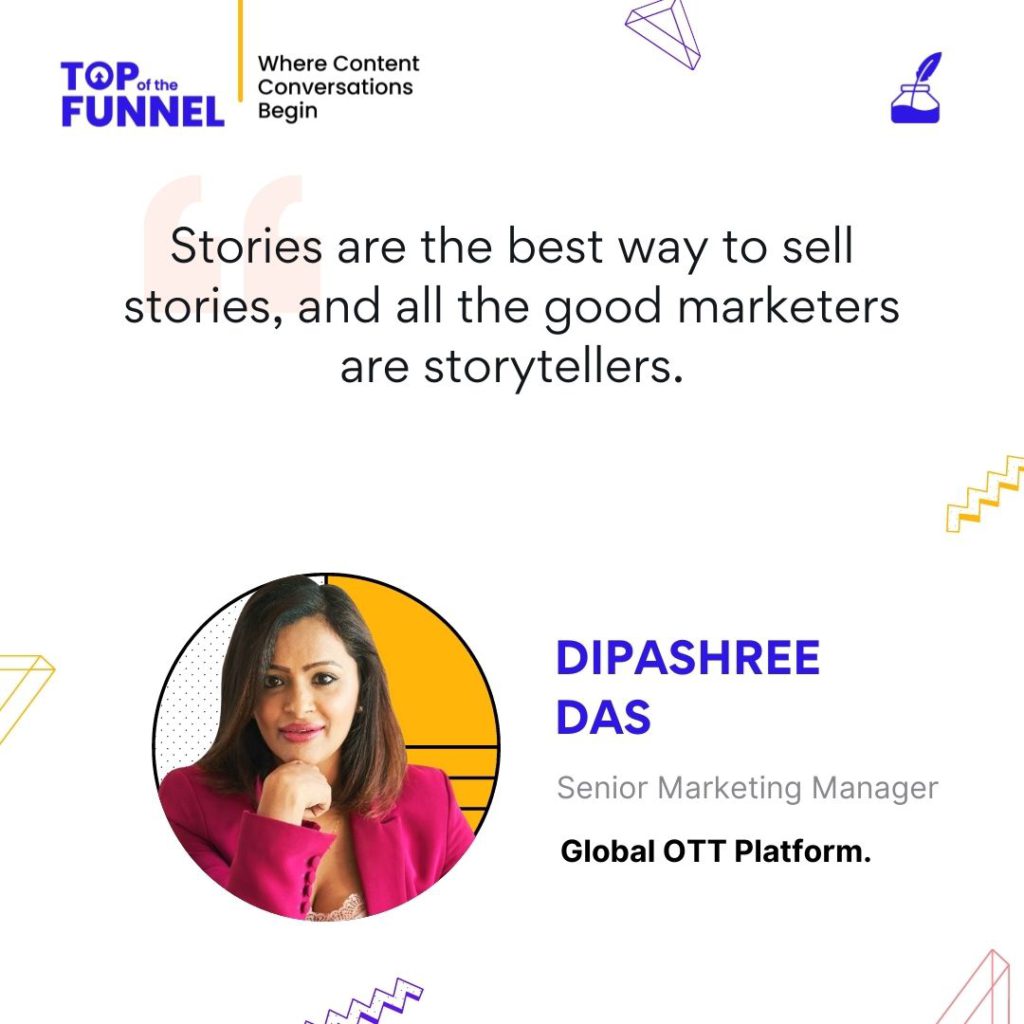
Natasha Puri: Good times for content marketers!
Dipashree Das: I sincerely hope so. At least, no one is calling it teenage sex anymore.
Natasha Puri: It is only getting better.
Dipashree Das: I loved my time with NDTV. I was still working with them in my first six months in Singapore. I was trying to set up a bureau in Singapore. But, the costs and the benefit ratio did not add up. There was not enough news to report. To operate a bureau, you need a camera person and others. It cannot be a one-man team. So, it did not work out.
Natasha Puri: I love how we are so optimistic about the growth of content marketing. The pandemic has also accelerated the demand for content marketing. There are designations now, which are specifically for content marketing people. At one point in time, there was a marketer, whom you gave content work to do. It was mixed up. A content marketer, content writer, and content strategist were doing the same thing. Hopefully, this gets better.
Another thing we spoke of in our previous conversation was the role of community. In earlier conversations, many senior leaders have spoken of how the community has become such an important part of the marketing framework. What is the role of community in marketing, according to you? How do you think brands can leverage to build solid communities?
Dipashree Das: This is a great question, for I have thought about this in all my jobs. I am quoting from one of my favorite marketing think tanks. In 2019 there was a Ted Talk titled ‘Tribes are all that matter now.’
Brands and communities have always been important. One of the OG community brand builders was Harley Davidson. He had identified people with similar interests together and made their brand one of the facilitators that brings them together.
The brands are always secondary. This is where most brands go wrong. They put people secondary. They think people come together because of the brand. They do not. They come together because of the common interest that binds them together. This is one of the primary tenets that we should always keep in mind.
Why is it so important? Google might judge me for stating this data, but it is insane. Google Million Report for 2020 stated that 40 million consumers have joined the internet space since last year. It is like multiple countries have joined the internet. 70% of those people have said that they want to stay back, meaning they will do one to three visits to the internet, at least three times a week. What does that mean for marketers like you and me? It means that these consumers will act differently than the existing consumers. If they were shopping online before this, they would start shopping online. They might even consider studying online. Sometimes we do not have a choice. The reason they turned to online modes of education is to educate their children or themselves. Online fitness became a thing because you had no choice. The way we are conversing online now, we would have done this in person. But, the pandemic has left us with no choice. The typography of the landscape has changed.
We could sit back and wait for things to get back to ‘normal.’ Or, we could together and realize that this is probably the ‘new normal.’ If 70% of people are saying that their habits have forever changed, it is contingent upon marketers of any form in any category to try and understand that in their category, what is the change that has taken place? The change will not be the same in every category. For fitness, education, or ed-tech the change has been revolutionary. In some segments, the change may be little. But, as a shift has occurred. The first step would be to recognize that change and step into community building, keeping that in mind.
Let us go back to the basics, keeping the scenario change situation aside. Why did we form communities in the first place? We formed communities in the absolute earliest caveman days because we cannot survive alone. We banded together because of food and survival needs. We also wanted to come together and share our stories. We wanted to pass on our skills, and so on. Communities were formed to tell stories. Why are people building communities again?
People come together in this hyper-digitalized world for a couple of reasons. At a superficial level, we are looking for a ‘search.’ If I am new, I will look for influencers to better inform my search. Then, I will look for the vindication of the search. Did I search for the right thing? Did I completely end up searching for a completely different thing? Let us go a step deeper. Then, I will look for people with common interests, or look for new interests. Let us say, for example, that you love music. If I am new to the internet space, I will look for people with similar interests like jazz music.
In my understanding, the deepest and third level is that in a hyper digitized world and the increasingly polarized world because of the distancing, we are looking for some sense of belonging. This belonging can come from several emotional reasons. A brand can bring us together because of what they are offering. If a brand can make these happen, you have successfully built a community. The question arises as to whether your brand tapped into these. These needs were always there. They have been heightened because 40 million new people have joined and they have no idea how to navigate this space.
For example, my mom is relatively new to the internet. She had been using Whatsapp. But, over the last year, most of her interactions with friends and groups have happened over Zoom. At the ripe old age of 75, she has learned how to use Zoom. All categories are targeting her. Do they know what she is using Google for? Have they applied these three levers that I spoke of? Is there a community that they are building for her? Are brands identifying that need? The need for communities was always there. The need for brands to recognize that potential has heightened. So, whoever is ready to strike when the iron is hot, will build superb communities. Everybody else will be a little late to the party. The need for belonging in a hyper-digitalized and increasingly polarized world is why there is a need for brand builders to quickly rally a brand.
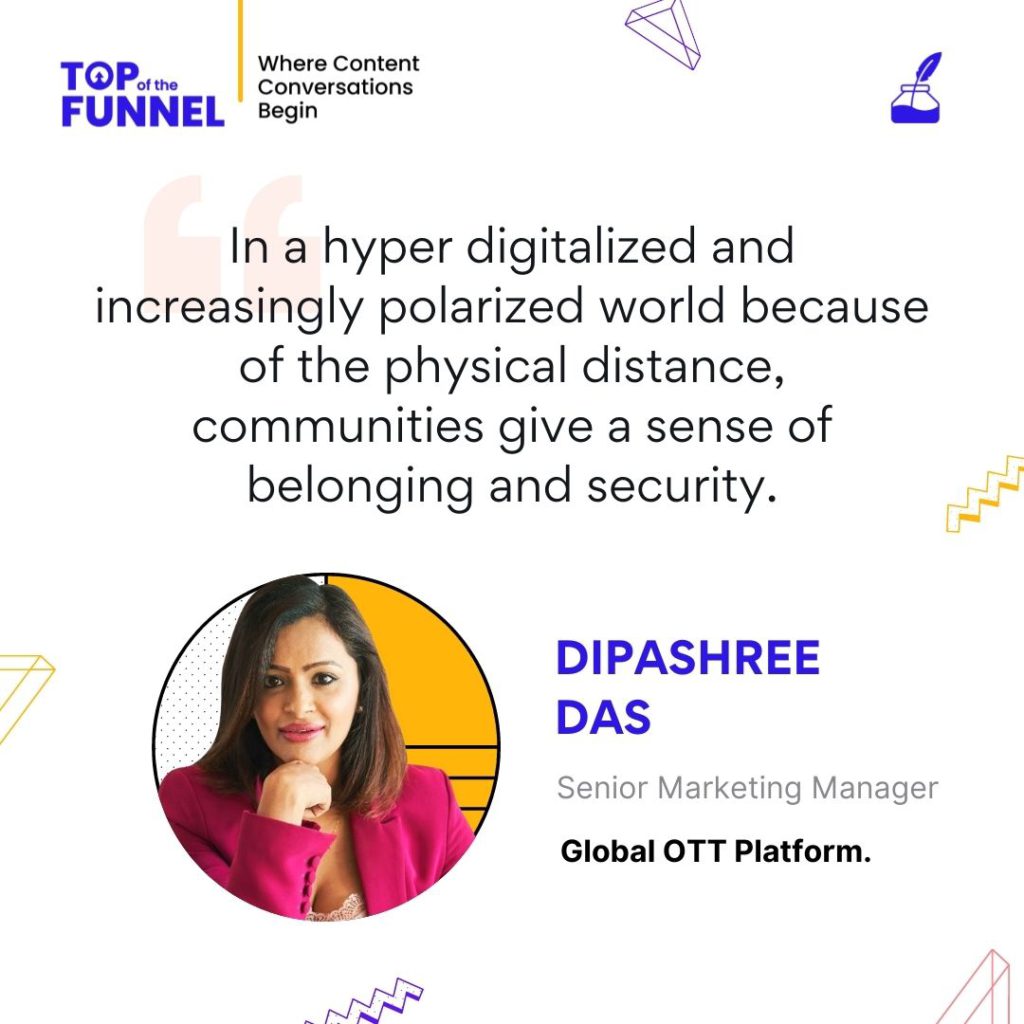
Natasha Puri: This is where the power of content lies. If you are creating a lot of content and you do not have a community to distribute that content and take that content to the next level, there is no point in creating content.
Dipashree Das: Storytelling is the best way to build a community. I know that several marketers may not agree with me. I think that the tribal way of sitting around a fire and telling stories is our core genetic codification that has not changed. I think that the components of good stories have remained unchanged. What essentially makes for a compelling story? Creative risk is very important. We shudder at the concept of creative risk. What kind of creative risk are you leaning into as a brand, that ladders up to the narrative that you want to build? Let us leave the branding discussions to the custodians of the brand.
There is so much fatigue around repetitive stories. If you want to build and scale a community, it is very important to tell interesting stories. Interesting stories do not just get told. There is always an element of creativity. And, creativity has risks involved.
Another thing that I want to touch upon is that many times, startups come up and say that they have a great idea and then they stop. Do you realize that when you are building a community in content marketing, the two top things to remember are relevance and consistency? This is where the boring world of content marketing begins. Everybody wants to tell a good story. But, when you ask them what is their content strategy, they draw a blank. Who is your consumer? What is their persona? What is their buyer decision process? How are you going to tell them about this? On which platform? They are often confused and do not know where to begin with.
Natasha Puri: This is the classic case of confusing a campaign with a content strategy.
Dipashree Das: A piece of content is always the answer to a question. That question is whatever you are seeking to build. The third most important question to ask is how are you going to sustain that strategy? Is there a team? Are there resources? Is there money to keep the fuel burning for a long year, or into the process? Are there success metrics in place? The first time that I was asked to do this, they wanted results in six months. I sat them down and said that they won’t achieve anything in six months. Nada. I need at least 12 months to create awareness. I am starting from scratch. No one knows about your brand.
Community building is especially tougher for a brand that nobody knows about yet. You have to spend a lot of time thinking about the parameters of success that you want in place. Content is a very interesting thing. My submission to anyone listening to this conversation is that there will be excitement. The art is to temper that excitement with science. Science is meant to calibrate your expectations for a little bit. Make sure that you are building communities in a calibrated fashion. Make sure that you are not burning all the ends of your matchstick.
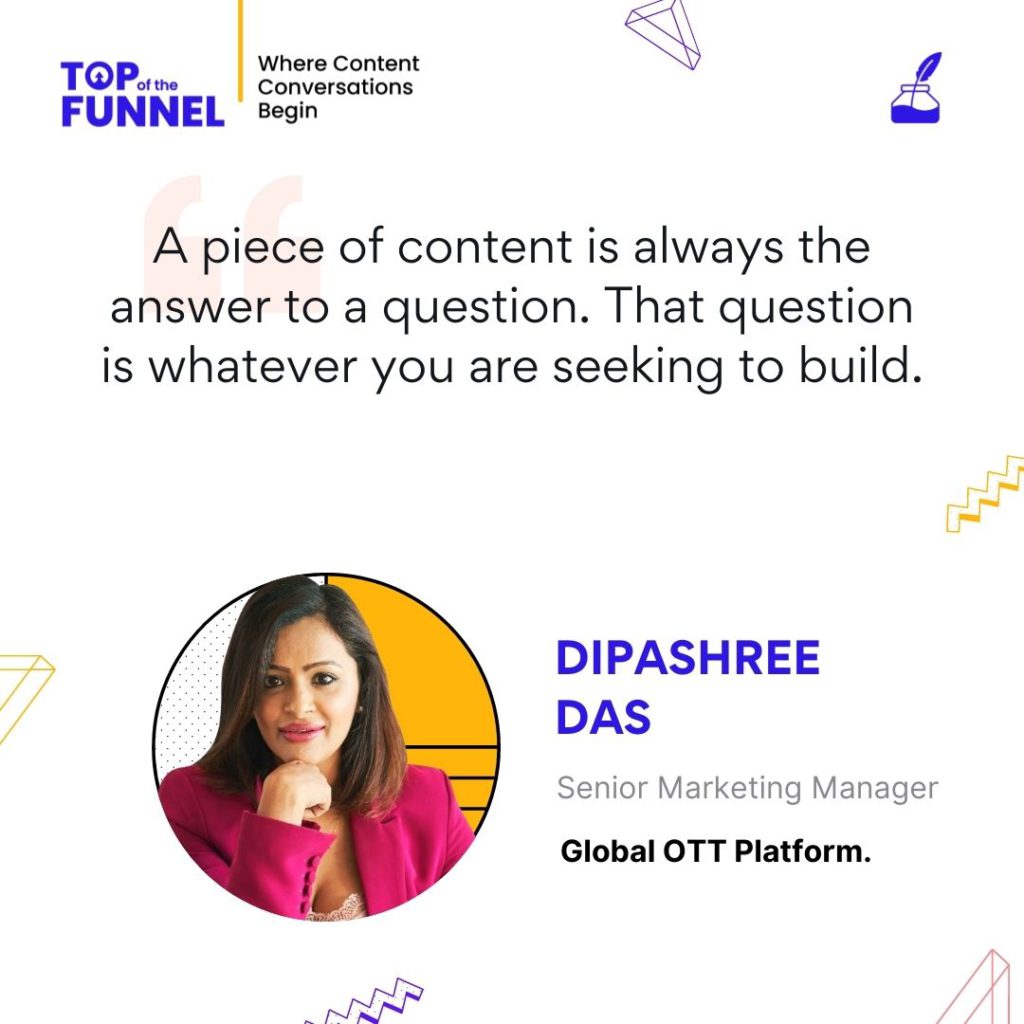
Natasha Puri: I feel like rewinding this over and over again. This is so important. As a creative person, it is so easy to dive into this. But, after one piece of content, you will reach burnout. You will expect to see some results after one piece of content. But, it won’t yield anything. To sustain yourself creatively, you have to understand that it is a long-term process. For creative people, it is so important to have that reality check, if they are venturing into content marketing.
Dipashree Das: I will give you an analogy, which someone gave one. Content marketing is not a fling. It is a marriage. And, we all know what marriages are like. Before you get into it, think about it.
Natasha Puri: It is so quotable.
Dipashree Das: This is not mine. But, someone said this to me. And, it makes sense.
Natasha Puri: How do you think the pandemic has impacted content marketing as a field? Would you like to talk about some great campaigns that you feel show how content marketing has evolved in these times?
Dipashree Das: When Vice President, Kamala Harris was sworn in, it was a very proud moment for us. There was a campaign done by the Girl Up foundation. I have read about them. The cherry piece of that campaign was a beautiful video, where the director crowdsourced footage from homes across the world, where little girls were getting ready to watch the swearing-in of Kamala Harris. You do not see her on-screen. You only watch the girls getting ready. You see the swearing-in from their expressions, as they are finally able to see what is possible for them 20, 30, or 40 years from now. They are finally able to see what they can be. It was a beautiful campaign.
I do not think anyone involved in this video took any money from it because Girl up is a charitable foundation. I think it is beautiful that they did something like this. Their message was that you cannot be, what you cannot see. She said, “I am the first, but I won’t be the last.” Little girls across the world thought someone who looked like them can be in the White House. It gave me goosebumps.
One of my teammates did a brilliant job with people going crazy over the Jaldi Aao album on the latest season of Money Heist. Kudos to them! Tara, Divya, Shagun, and my manager did an incredible job with the thinking and execution. The amount of love that we got from it is the real community building. Everyone from the Mumbai police to the influencers spoke about it. It did not miss a beat. Despite being a global show, it resonated with a wide variety of people. This is the beauty of a really good story. Language does not matter. It is a Spanish show. But, who cares? People love it.
People had to get creative in producing media during the pandemic. I remember advertisements being shot using virtual screens and really limited resources at home. Google Duo shot ads using their employee’s families. These are some incredible examples of how people did their content marketing, advertising, and management during the pandemic.
Necessity is the mother of invention.
People became creative. When our first campaign became virtual, we were really confused. How do we shift team meetings to Google Hangouts in one day? Shooting campaigns virtually was tough. The show must go on. Many brands did not miss a beat. Some great stuff has been coming out.
Natasha Puri: From a creativity point of view, we are forced to think out of the box. So, it helped during the pandemic.
Dipashree Das: Technically, we were forced to think in the box, being inside the house.
Natasha Puri: Where do you think content marketing is headed in the future?
Dipashree Das: I think it has become sharper and more insightful. I love data. I posted yesterday on Linkedin how data improve our understanding of the process, but it cannot make our decisions for us. Data will play a huge role in how we build our communities and do our content marketing. Data won’t do the job for us. I do not like the word ‘data-driven.’ ‘Insight-driven’ seems better, in my opinion. We need to keep track of all kinds of data- new or old, big or small, we need to track the data of those 40 million people joining us this year to figure out their wants and motivations through their actions and digital footprint. Once we understand their motivations, we will have a finer blueprint of what our community-building efforts look like. It would lead us to become a little more authentic and nuanced about our community-building efforts.
One thing that several brands need to improve upon, with newer people joining in, is understanding the culture. It is a huge part of community building. Consumers are shaping, forming, creating, consuming, and breaking down culture, as you and I are speaking. They are at the forefront, the eye of the storm. If you as a community, or a brand builder, are not invested in that culture or immersed in understanding that sub-culture that impacts your new and existing consumers, you are missing out. You have to be, for lack of a better word, a culture junkie. I would leave the rest up to you, to figure out how to go about it. It does not have to be about data. It could just be about listening to your consumers. You have to inhabit their world.
In the future, the curtain between the consumer and the brand has to diminish even more. Some brands do it well. We know who they are. It is shocking to me, how a majority of the brands talk ‘at’ their customers. While they are advertising to their customers, they pretend to have a connection. It is not how communication works. It is not how content building or content marketing works. There is a fine line between community building and advertising.
A lot of big brands need to take this into account. The last and most important thing for brand and community builders to consider is what role your community-building has for the consumer. If your content marketing plan is not consumer-centric, it is not going to work.
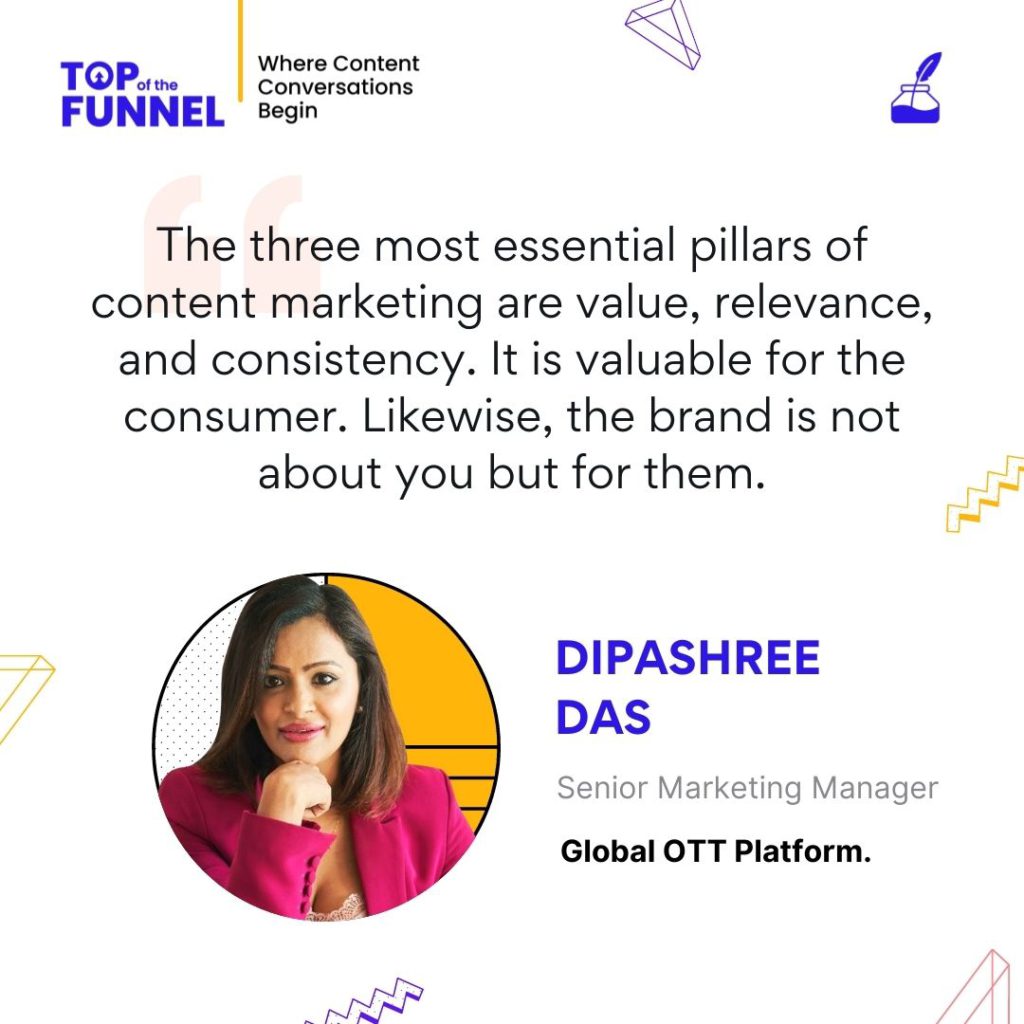
The new, 40 million people will force us to be so. I want to see these changes happen. We have to culture junkies. We have to be consumer-centric, instead of just pretending to be consumer-centric.
Natasha Puri: Thank you so much for doing this. I learned so much. It was a fun chat.
Latest Blogs
Learn how to rank on AI search engines like ChatGPT, Perplexity, and Gemini by optimizing your content for authority, structure, and relevance. Stay ahead in AI-driven search with this strategic guide.
Explore the best healthcare SEO services for your medical practice. Improve online visibility and effectively reach more patients in need of your services.
Discover top social media agencies specializing in banking solutions, enhancing financial services and driving engagement.
Get your hands on the latest news!
Similar Posts

Expert Speak
18 mins read
Season 2 Episode #1 How “The Godfather” of Content Marketing Rules His Domain: Hear It From Joe Pulizzi

Expert Speak
11 mins read
Episode #17: The Evolution of Travel Content and What’s Next with MakeMy Trip’s Ankita Sharma

Expert Speak
16 mins read